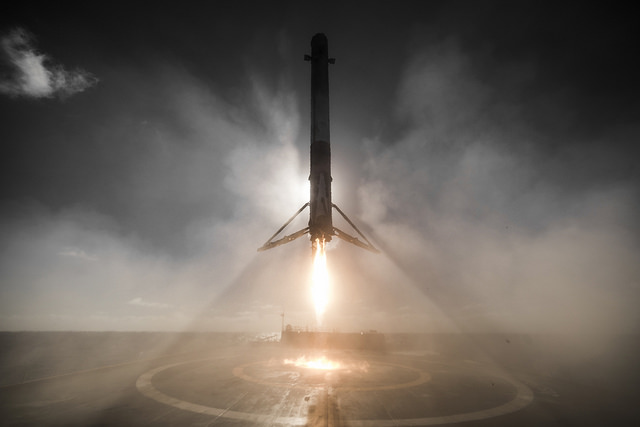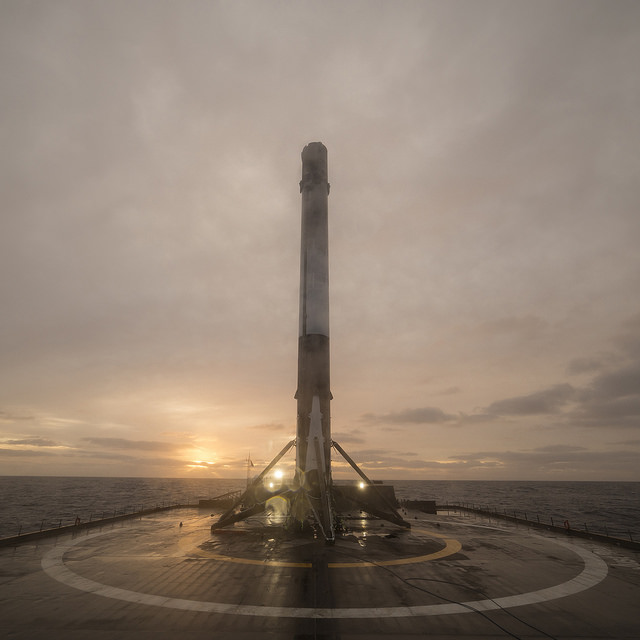
News from space exploration continues to amaze. Consider:
- Video of first time SpaceX recovered a booster
- China sees first commercial launch on government rocket
- Private sector, or what passes for it, in China gets into the launch business
- EU’s GPS satellites having lots of unexplained clock failures
Video of the first vertical recovery of a rocket – Beyond the Black highlights What happened at SpaceX the first time they landed a first stage – SpaceX had a bunch of camera operators recording when it tried to recover a booster. Great video. National Geographic produced a documentary on the successful effort. Check it out:
[youtube=https://youtu.be/brE21SBO2j8]
One more photo of a recovered Falcon 9 booster, after the successful lift of ten Iridium satellites into orbit:

1/10 – Spaceflight Now – Kuaizhou rocket lifts off on first commercial mission – Kuaizhou 1A booster saw its first commercial use in China, lifting three satellites into orbit. This is a modified ballistic missile, reportedly. This booster will go after the smallsat market.
Company representative says their charges are $10,000 a kilogram.
ExPace provided this launch. They are a subsidiary of China Aerospace Science and Industry Corp, or CASIC.
Expace is the second launch provider. China Great Wall Industry Corp was the first; they use the Long March rocket.
10/7/16 – Popular Science – China’s Private Space Industry Prepare to Compete with SpaceX and Blue Origin – The Kuaizhou 1 series will lift 200 kg into low earth orbit. The KZ-11 can lift 1.5 tons.
The Kuaizhou series is based on rockets used for anti-satellite and missile defense interceptors. It also used solid fuel, not liquid.
Haven’t done enough research to be sure in my own mind, but it looks like ExPace is a private sector company.
China Great Wall Industry Corporation website – Shareholder profile – This is a commercial company but more importantly it is a “State-owned business group”, meaning it is a commercial player but owned by the PRC. Their major brands are Shenzhou and Long March.
That makes two commercial providers of launch vehicles. Two.
One of them is in the private sector.
Step back and ponder….there are two commercial launch providers in China. Not official government or military. One of them is a private company. Imagine that.
(It is also possible I misunderstand the status of the two Chinese companies; I’m still learning, but then that is the whole reason I’m blogging!)
Astounding.
Let the competition roll!
Some of the competition isn’t doing so well….
1/18 – BBC News – Galileo satellites experiencing multiple clock failures – The EU has its own GPS navigation satellite system, called Galileo. It is designed to have more accuracy than the American system.
Purpose of system is so European users won’t be vulnerable to accuracy degrades by the US, Russian, or Chinese GPS constellations, should any of those players wish to do so in the event of a military conflict.
There will be 24 satellites in the system when fully deployed, plus a few extra for spares. Currently 18 are in orbit. One is close to complete failure.
Now there is a problem with failing clocks.
Each satellite has four atomic clocks, two rubidium and two hydrogen maser. Those give accuracy to within one second per three million years. That level of accuracy is needed to get the most precise location data.
Nine of the hyper accurate clocks have failed in orbit. One sat has 2 failures. That means 8 sats have lost one or more clocks.
No cause is known. The Indian satellites using the same technology have no failures. To complicate the worry, five maser failures were on early flights and three rubidium failures were on recent flights.
Expected total cost of the fully deployed system is currently sitting at 7B Euros. That would be about US$7.51B. The full system will have 6 spares; original budget was 5B Euros. That puts the current cost at:
- US$7.51B – full cost, current estimate
- 30 – full constellation of 24 satellites plus 6 spares
- US$250M – cost per satellite
One thought on “More amazing news from the open frontier of space”